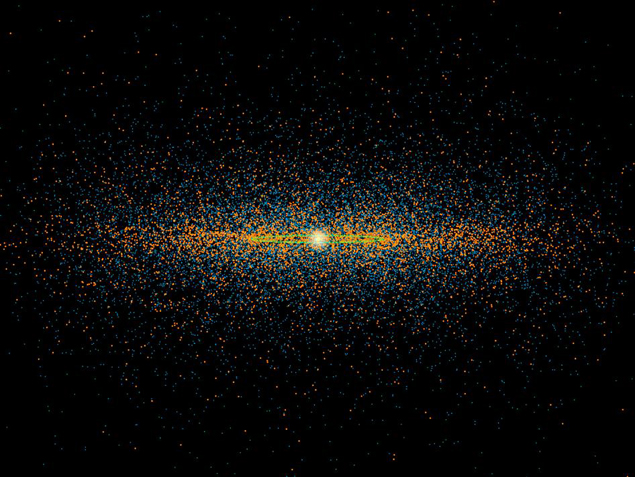NASA Checks Out Potentially Hazardous Asteroids

NASA finds there are more potentially hazardous asteroids (PHA)s, closely aligned with the plane of our solar system than previous models suggested. (Image: NASA/JPL-Caltech)
First, the good news. There are fewer asteroids near Earth than previously estimated. Now the bad news. A new NASA survey also finds there may be more than twice as many aligned with Earth’s orbit than thought, which could increase the odds of an asteroid coming close enough to us to cause concern.
The findings from NASA/JPL’s Near Earth Object Wide-field Infrared Explorer (NEOWISE)project also reveal new information about the origins and possible dangers these space objects might pose.
Potentially hazardous asteroids, or PHA’s, are a subset of a larger group of near-Earth asteroids, which come within eight million kilometers of us and are big enough to pass through Earth’s atmosphere, causing a great amount of damage.
To get a count on how many of these possible troublemakers are out there, NASA used one of its space telescopes to make an assessment of our solar system’s population of PHA’s.
WISE, an unmanned satellite carrying an infrared heat-sensitive telescope, was launched in December 2009 and spent a little over a year imaging the entire sky to provide data on asteroids, the coolest and dimmest stars, and the most radiant galaxies.
Approximately 4,700 PHAs, give or take about 1,500, with diameters larger than 100 meters, were found, according to NEOWISE principal investigator Amy Mainzer.
Most of the asteroids in our solar system never get close to Earth. They’re found in what’s called the Asteroid Belt, which is between the orbits of Mars and Jupiter.
Scientists think these asteroids may have been fragments that were trying to come together to form a planet when the solar system was forming. However, the overwhelminggravitational influence of Jupiter was so strong, it kept the planet from forming.
But, occasionally, if there is an interaction with one of the giant planets, some of the asteroids may be forced to wander away from the main belt and into near-Earth space – causing concern for those of here on terra firma.
To make their tally, Mainzer along with her colleagues at JPL examined approximately 107 PHA’s with WISE telescope data, providing them with a representative sample of the total population of these potentially dangerous objects.
From that sample, Mainzer’s team was able to calculate the total number of PHA’s in the solar system.

This diagram illustrates the differences between orbits of a typical near-Earth asteroid (blue) and a potentially hazardous asteroid (PHA) (orange). (Image: NASA/JPL-Caltech)
Of course, the big question remains how likely is it that one of these potentially-hazardous asteroids actually could strike Earth. Mainzer, looking back at Earth’s history, points out that major asteroid strikes very rarely happen. Scientists estimate that such a major hit happens every 100 million years or so. The last mammoth asteroid collided with Earth about 65 million years ago, causing, scientists think, the extinction of most life on our planet, including the dinosaurs.
Mainzer says astronomers have already discovered most of the significant asteroids out there. However, she warns, there are many smaller asteroids, which haven’t been discovered yet. The NEOWISE study indicates that only between 20 and 30 percent of these have been discovered so far.
To keep us safer from asteroid impacts, Mainzer says the most important thing that we can do is actually go look for them. “Because, if you don’t know where they are, you have no idea how to really deal with any risk,” she says.
Mainzer and her colleagues are currently working on a proposal to build and carry out an advanced survey mission. Called the Near Earth Object Camera (NEOCam), this proposed mission would locate many more asteroids to provide a more accurate picture of the total asteroid population.
Dr. Amy Mainzer joins us on this week’s radio edition of Science World. Check out the right column for scheduled air-times or listen to the interview with Dr. Mainzer below. VOA
Other stories we cover on the “Science World” radio program this week include:
- Success! Privately-funded cargo spacecraft docks with the ISS
- Recommendation to halt prostate cancer screening stirs controversy
- Scientists, lawmakers target invasive Asian fish species
- Babies born by C-section more likely to become obese, study says

No comments:
Post a Comment